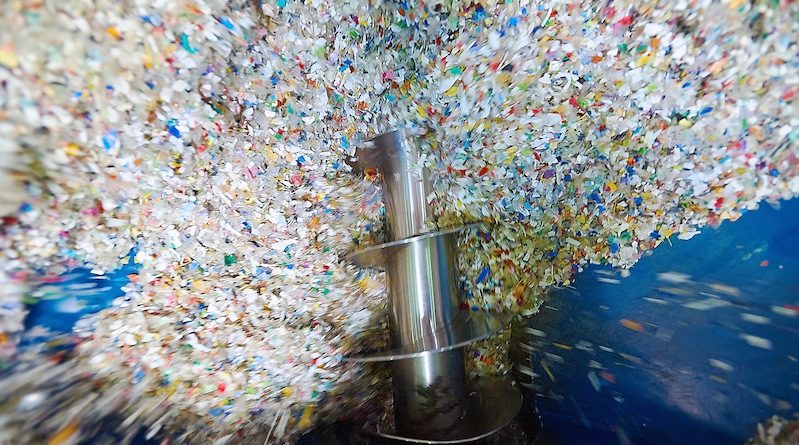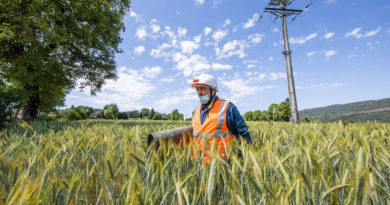
Towards plastic resourcing
The decision of the Chinese government to ban imports of plastic waste as early as January 2018 is having a big impact on current plastic recycling markets and industry.
Is it a good omen, boding well for the future of recycling, or a looming disaster that will leave the whole industry in limbo? As the process unfolds, both doomsayers and utopians will certainly be proven wrong, leaving market players and regulators with a daunting yet exciting task of moving from a purely quantitative approach to a more quality based plastic recycling industry.
Recognizing this momentum, the European Commission recently published its strategy on plastics.
To companies like Veolia, this initiative is an opportunity to shed light on closely intertwined challenges that can harness the benefits of plastics while addressing its drawbacks.
As the the overall production of plastics is still booming, setting up an efficient plastic recycling value chain is crucial to meet policy objectives.
A buoyant environment for plastics recycling and recyclers
When looking into plastic production, figures are striking and call for a global response, as plastics have grown ubiquitous but generate a lot of waste.
World production of plastics is continuously increasing: it is currently 330 Mt p.a. and is expected to quadruple by 2050.
Most of it comes from Asia (50%), followed by Europe and Russia (21%) and the three NAFTA countries (18%). Demand is also largely dominated by Asia.
It is distributed among the packaging sectors, which account for 30% of the world’s packaging sector and even 40% in Europe, followed by construction (25%), automotive (17%) and agriculture (8%).
From a market oriented perspective, the turnover of the global plastics market can be estimated at €300 billion, despite the fragmentation of players and the large share of the informal sector.
Regarding recycled plastics, the size of the market is 15 times smaller, i.e. €20 billion.
Nonetheless, there is significant growth potential as only 9% of the tonnages produced between 1950 and 2015 were recycled.
Today, the recycling rate of plastic is still very low compared to other materials.
However, manufacturers are starting to rethink their production methods and forecasts predict that the market for recycled plastics is expected to grow by 7% per year by 2025, faster than for virgin plastic production. But numerous obstacles and issues have not been yet addressed.
The need to overcome existing barriers to set up a resilient plastics recycling industry in Europe
Veolia’s revenues in plastic reprocessing are currently €280 million/y and we expect to continue expanding our activities in this field.
From an industrial perspective, the narrow path between the devil (ambitious yet unreachable targets without required investment) and the deep blue sea (unsustainable flows of poor quality recyclates) would be to help the whole value chain of plastic recycling to adjust its economic equilibrium, treatment capacities, and innovative technologies to this new qualitative leap.
This would require urgently addressing the following issues:
› low oil prices, which hamper the profitability of plastics recycling: at $50 a barrel, new plastics are cheaper than recycled plastics;
› collection difficulties, particularly for packaging, and challenges in sorting mixed plastics;
› psychological as well as regulatory barriers to the use of recycled plastics by industry, such as norms or standards restricting or limiting the intake of recycled plastics;
› the lack of investment in new treatment capacities and innovation, especially in the realm of hard, multilayer and composite plastics (computer shells, mobile phones, car bumpers, etc.).
In this context and provided some of these barriers could be lifted, Veolia’s ambition is to structure a recycling and recovery industry for plastics and to offer an alternative to virgin materials that meets our clients’ specifications and grade: in a nutshell, we aim to help reinvent the plastics market by integrating it into the circular economy.
In practice, we have already included this ambition in our business objectives as we plan to increase our turnover in this activity to €1 billion by 2025.
The inclusion of the economics of plastics in a more global circular economy strateg
The main challenge, in our view, is to develop the demand for recycled raw materials, thereby relocating part of this industry to Europe and meeting ambitious recycling targets at national and European level.
Creating new outlets for recycled plastics is, indeed, a prerequisite if market players are to invest time, money and expertise in the undertaking.
In this respect, the pledge by industry to incorporate 10 million tonnes by 2025 is a great first step.
Should European industry not live up to this ambitious task, other policy options could be activated, such as minimum recycled contents for manufacturers to incorporate more recycled plastics into their production processes.
Public procurement also represent a powerful pull, as contracting authorities have the means to set the rest of the value chain in motion.
As is often the case for business undertakings, the anticipated costs and return oninvestment tend to take precedence over other considerations.
In recent years, the recycling sector has been undermined by price volatility on both waste bales and virgin prices, which jeopardizes the economic equilibrium of recycling companies and deters their clients.
If nothing is done, a whole sector of activity could disappear along with the industrial and technological edge that has been developed over decades.
This implies that the price of recycled plastics should be competitive enough for producers to make the right decision both for themselves and for the environment.
To this aim, Veolia has long advocated monetizing the environmental benefit of recycling, preferably at European level.
The available policy toolkit is well known carbon tax, reduced VAT, recycled raw-material tax credit, exemption from energy taxes but political will is essential to restore the imbalance between the prices of virgin and recycled plastics, especially at Member State level.
Besides the obvious notion of profitability, lack of visibility and clarity can deter market players from investing in a given business.
Plastics recycling being at the crossroads of product manufacturing and waste management, both sides should be consistently regulated to avoid frictions and uncertainty when transiting from one status to the other.
The EU communication on the interface between chemical, product and waste legislation as well as the outcome of the negotiations on the new waste directives are unique opportunities to solve the conundrum facing recycling markets: how to phase out substances of concern and increase recycling rates at the same time? Indeed, some of these legacy substances, today deemed “of concern”, were added to plastics years ago and are now found in plastic waste.
A pragmatic approach is therefore needed to facilitate the transition to a toxic-free material flow, which should be our primary goal, while allowing valuable materials to be recycled for specific uses, provided this is based on a proper risk assessment.
According to the Ellen MacArthur Foundation, “Without fundamental redesign and innovation, about 30% of plastic packaging will never be reused or recycled”. This is a wake-up call for the industry as a whole to cooperate better, including upstream players like plastic producers and product manufacturers but also downstream players like recycling and waste management companies.
Indeed, the lack of interaction between design and recycling experts can impact the recyclability of products once it becomes waste.
As recyclability is broader than just dismantling, product manufacturers should ensure that an economically and technically viable recycling industry can actually deal with their plastics and the additives they contain.
Conclusion
The transition towards circular economy has led to profound changes in the missions of our company.
Our role is no longer just to eliminate waste but to re-inject it into the economy. Our business model has evolved from a service operator to a producer of renewable resources.
As both markets and regulation are the main drivers behind this move, regulators and companies should continue working closely together to ensure that our waste can become the Secondary Raw Materials our economy needs to prosper.




